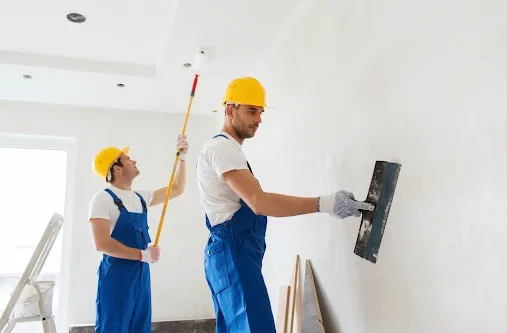What is Wall Putty?
Wall Putty is a white cement-based fine powder cement which is mixed with water & other additives to create a solution that is applied to the wall. Wall putty also serves as a filling agent to cover cracks, imperfections, patches, pores, and gaps in the walls. The smooth mixture of wall putty and water fits perfectly over any type of wall to create a flawless surface in the interior or exterior of your house.
Wall putty can be used on both wet as well as dry walls and interior as well as exterior walls as its primary purpose is that of being a protective agent. The wall putty is designed in a manner that it can be applied to any type of wall, even while renovating the home.
The first coat is applied to fill any uneven surface on the wall while the second coat ensures appropriate smoothness and finishing before proceeding for paint.
Benefits of Using Wall Putty
- Wall putty paint gives a smoother finish to the wall.
- It effectively waterproofs the wall and retains moisture.
- It does not flake easily to damage your wall.
- You can use wall putty to increase the lifespan of your expensive paint.
- The paint is glued perfectly to the wall with the help of a wall putty colour.
- Strong binding with building surfaces

How to use a wall putty?
The way you apply the wall putty is what really matters. If you really want to achieve that silky smooth feel, you have to know how to apply it correctly. For this, you’ll need a few materials:
- The wall putty
- Water
- An electric putty mixer
- Sandpaper, wire brush, or putty blade
- A finishing tool (blade, trowel, or spatula)
Let us go over the process step by step.
Surface preparation
Before anything, you’ll need to make sure that your targeted surface is ready to receive the putty.
- Eliminate any fungus, leakages, or dampness from the wall through treatments
- Clean the surface completely. Make sure to wipe out any dust, residual paints, oil, loose particles, or any other contaminants. You can use a wire brush, putty blade or sandpaper, to wipe off the loose materials.
- Finally, wet the wall with ample water and let it dry. The surface should be a little wet but not over-wet.
Mixing
If you are dealing with cement-based putty, this step is where you mix the powder with water to form an applicable solution.
- The general thumb rule is two parts cement putty and one part water (2:1) This ratio varies according to the manufacturer’s instructions.
- Mix well for at least 15 min using electric putty mixer or by hand to get a consistent, creamy paste.
- Mix them properly to ensure that the paste is free from lumps
Apply the putty
- Before applying the putty, best practice dictates is to apply a coat of primer and let it dry overnight (although some manufacturers don’t recommend applying primer first).
- Take your putty mix and using a finishing tool (trowel, spatula, or blade), apply the first coat in a bottom-to-top manner.
- Let the first coat dry. This should take about 6-8 hours.
- After the first coat, gently rub the surface using sandpaper to get rid of small, loose particles.
- Apply a second coat of putty.
- Allow the surface to dry for about 6-8 hours, then gently rub the surface using sandpaper to remove unevenness. This should reveal a smooth, glossy finish.
- Avoid applying thick layers of putty, as it can lead to cracking and peeling.
- Now your surface is ready to paint.
Types of Wall Putty
Cement based wall putty
Cement-based wall putty is the most frequently used wall putty for internal as well as external walls. It is made up of white cement, polymers, and minerals and leaves a smooth and sleek finish.It fills in any gaps, cracks, or imperfections on the surface, creating a smooth base for the paint. Additionally, it offers great workability and prevents the growth of algae and fungi.

Acrylic Wall Putty
Acrylic wall putty is water based and made with white pigments, acrylic emulsion medium, and additives. Acrylic wall putty is well-suited for internal applications only and offers smooth and matte finish. Its binding properties are lower than that of white cement-based putty.Its smooth finish creates a perfect base for painting and prevents the growth of algae and fungi on walls. It is ideal for interior walls, especially on surfaces prone to cracking, such as plasterboards. Acrylic wall putty is suitable for all kinds of paints and dries up faster which reduces the labor time.

Gypsum-based Wall Putty
Gypsum-based wall putty is formulated using gypsum powder as the main ingredient.It provides a smooth finish and excellent adhesion to surfaces. It is suitable for high-humidity areas like bathrooms and kitchens

Polymer-based Wall Putty
Polymer-based wall putty combines the advantages of both cement and polymer materials. Unlike traditional putties made of cement, sand, and water, polymer-based putties use polymers to improve adhesion, flexibility, and water resistance. They also offer a smooth finish, ideal for levelling and filling cracks and holes in walls. This type of putty provides enhanced water resistance and durability, making it ideal for areas prone to moisture or frequent cleaning.

Conclusion
Wall putty is vital in achieving a smooth and flawless wall surface. Based on the specific requirements of your project, the surface condition, and the desired result select the appropriate wall putty. By understanding the different types of wall putty and their uses, you can ensure a smooth and durable surface that forms the perfect finish for your interior or exterior paint job.


